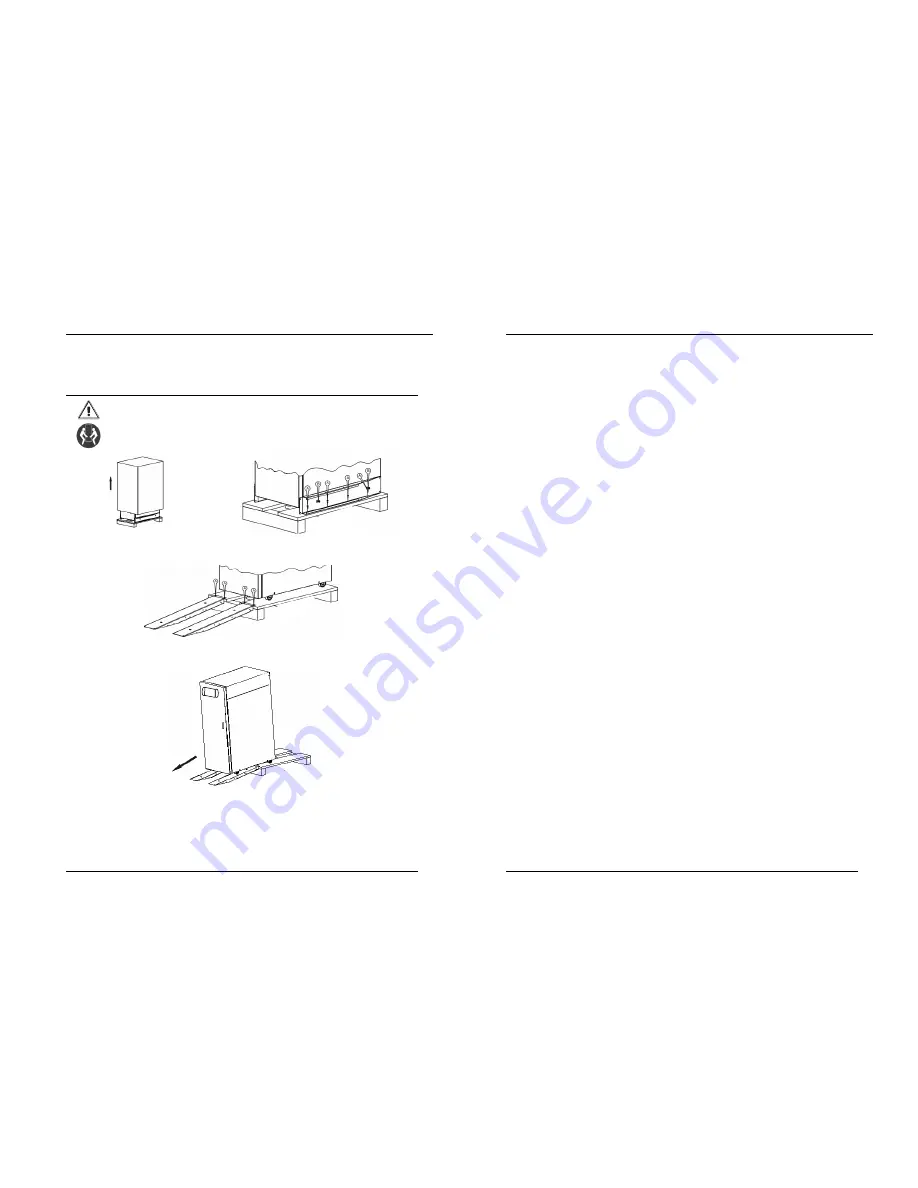
-
11
-
NS3000 Series User Manual rev.01
REMOVING THE UPS FROM THE PALLET
Fig 2-1 UPS Packing Diagram
CAUTION! TO AVOID HARMING PEOPLE AND/OR DAMAGING THE EQUIPMENT, FOLLOW
CAREFULLY THE FOLLOWING INSTRUCTIONS.
SOME OF THESE INSTRUCTIONS NEED TO BE CARRIED OUT BY TWO PEOPLE.
Cut the straps and remove the cardboard box by
sliding it upwards.
§
Remove the 2 brackets securing the UPS to the pallet by unscrewing the
screws.
§
The previously removed brackets can also be used as slides. Secure the slides to the pallet by using the type A screws, making sure
they are aligned with the wheels.
§
Screw the brake rod completely, so to separate it from the pallet
§
Make sure that the door is firmly closed.
§
CAUTION! Push the UPS from the rear with great care. Given the weight of the equipment,
this operation needs to be carried out
by two people
NOTE : It is recommended to keep all parts of the packaging for further use
Tip: Dismantle the bolts that connect the cabinet and wooden pallet after disassembly, then lift the cabinet to installation position. The
dismantlement should be careful so as not to scratch the body.
-
12
-
NS3000 Series User Manual rev.01
Verify the product label and confirm the correctness of the equipment. The equipment label is attached on the back
of front door. The UPS model, capacity and main parameters are marked on the label.
Warm Tips: Please dispose the wasted materials in accordance with environmental protection requirements
after disassembly.
To prolong the service life, the place chosen for the UPS must guarantee:
l
Easy wiring
l
Sufficient space for operation
l
Air sufficient enough to dispel heat produced by UPS
l
Against ambient corrosive gases
l
Against excessive humidity and heat sources
l
Against dust
l
With the current fire prevention requirements
l
The operating environment temperature is within 20
-25
. The batteries are at maximum efficiency in this
temperature range (for information about the battery storage and transportation as well as the environment, please
refer to table 8-2)
2.3.2 UPS Composition
10KVA~30KVA cabinet
2.3.3 Operation Space
As UPS has no ventilation grills at either side, no clearances are required for the sides.
To enable routine tightening of power terminations within the cabinet, it is recommended that clearance around the
front and back of the equipment should be sufficient to enable free passage of personnel with the doors fully opened.
The back door of the cabinet is more than 800mm from the wall or other cabinets.
Distance from the back
≥
200mm
2.3.4 Front and Back Access
The component layout of the UPS supports front and back access for servicing, diagnosing and repairing the UPS,
thus reducing the space requirement for side access.
2.3.5 Final Positioning
When the equipment has been finally positioned, ensure the adjustable feet is set so that the UPS will remain
stationary and stable.
2.3.6 Cable Entry
A lower incoming line is used for 10KVA~30KVA UPS.
2.4 Protective Devices
For safety concerns, it is recommended to install external circuit breakers or other protective devices for the input
AC supply of the UPS system.
We suggest to choose the input automatic break Bigger than internal automatic Breaker and D curve for the selectivity
with internal UPS protection.
This section provides generic practical information for qualified installation engineers. The installation engineers
should have the knowledge of the regulatory wiring standards, and of the equipment to be installed.







































